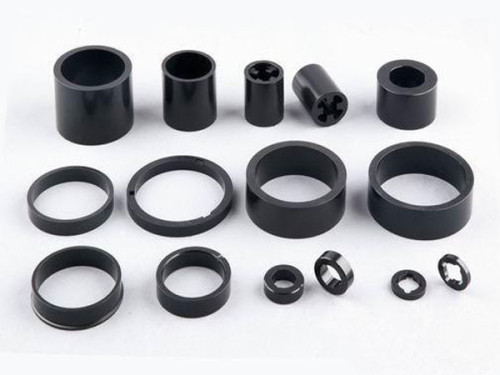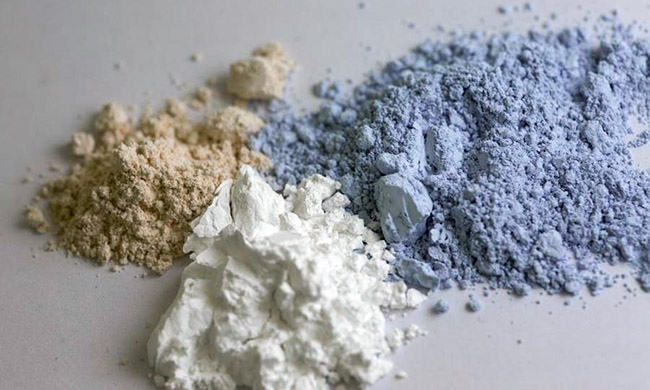Bonded magnet manufacturing-manufacturing process and process classification
Bonded magnets are composites composed of magnetic powders, binders and appropriate additives. The magnetic properties of bonded magnets are mainly determined by the average value of the performance of each magnetic powder with negligible interaction, although some studies have tried to use low Melting point metals or alloys are used as adhesives, but the adhesives used in mass-produced bonded magnets are all polymer materials.
The difference between bonded magnets and sintered magnets
Unlike sintered magnets, the individual powder particles of bonded magnets must have a sufficiently high coercivity. If the phase composition and microstructure required for high coercivity are severely damaged during the powdering process, it cannot be made good. For bonded magnets, the coercivity has been greatly reduced due to the damage of the grain boundary phase and particle oxidation.
Another major difference between bonded magnets and sintered magnets is that their magnetic properties are greatly reduced. We know that the maximum magnetic energy product of a magnet is proportional to the square of its remanence, and remanence is related to the saturation magnetic flux density, orientation and volume of the magnetic powder in the magnet. The filling rate is proportional. The adhesive and additives occupy a considerable volume (close to 20%) in the bonded magnet, and many bonded magnets are not oriented. Even for oriented magnets, the degree of orientation is difficult to achieve The sintered magnet is at the same level, so the performance of the bonded magnet with the same volume is far inferior to that of the sintered magnet.
Advantages of bonded magnets
Bonded magnets occupies an important position in the field of rare earth permanent magnets with the advantages of good performance consistency, precise size, complex shape, high material utilization, and easy integration with metal/plastic parts. The most important variety is the isotropic bonded magnet made of fast-quenched NdFeB magnetic powder.
The preparation process and advantages and disadvantages of bonded magnets
According to the difference in the processing characteristics of polymer materials, the forming of bonded magnets can be divided into four types: compression, injection, extrusion and calendering. The following figure is a schematic diagram of the four forming process flow.
Isotropic rapid quenching rare earth permanent magnet powder
The preparation method of bonded NdFeB magnetic powder is completely different from that of sintered NdFeB, because the alloy ingot or sintered body of sintered NdFeB does not have practical coercivity after being crushed to the particle size for bonded magnets. The preparation method for mass production is inert In a gas environment, the molten alloy condenses into a microcrystalline or even amorphous structure at a cooling rate of 105~106℃/s, and then undergoes crystallization heat treatment to grow the crystal grains to tens or hundreds of nanometers, which is less than the critical size of the Nd2Fe14B single domain High intrinsic coercivity is obtained in the sub-micron grains.
image
Generally, it is difficult for magnetic powder to be crushed to such small single crystal particles, and the technology of directional growth of sub-micron grains by rapid quenching is not yet mature. Therefore, the melt-spinning rapid quenching method is made of polycrystalline powder, and the easy magnetization axis of each crystal grain is not Strong alignment tendency, magnetic powder is isotropic. Such a high cooling rate is achieved by pouring or spraying the hot molten alloy liquid onto a water-cooled rotating copper wheel with a linear velocity of 16~30m/s. The liquid alloy is thrown out in the tangential direction under the acceleration of the rotating copper wheel. It is condensed into a thin ribbon with a thickness of ~100μm, and the cooling rate sensitively determines the grain size of the alloy ribbon, thereby sensitively affecting the shape of the magnetic powder demagnetization curve and the intrinsic coercivity.
Since the cooling rate depends on many factors such as alloy liquid temperature, flow rate, copper wheel speed and temperature, and argon atmosphere, it is difficult to strictly control and optimize simultaneously. If the optimal quenched nanocrystalline metallographic structure is used as the mass production target, it is very It is easy to cause the grain size distribution to be too wide, and the corresponding grain intrinsic coercive force distribution is also very wide, resulting in poor squareness of the demagnetization curve of the magnetic powder. Therefore, in actual production, the magnetic powder is usually quickly condensed to a partially amorphous state at a wheel speed that is appropriately higher than the optimal linear speed, and then crystallization is processed at 630°C to adjust the crystalline state to an average crystal grain size of 40nm. In order to achieve stable and good permanent magnet characteristics, the American Magquesque Corporation, which dominates the isotropic rapid quenching Nd-Fe-B market, adopts such a technical route to produce.
Anisotropic rapid quenching rare earth permanent magnet powder prepared by HDDR process
The HDDR process is a very effective technical means for producing anisotropic NdFeB magnetic powder. The HDDR process includes four stages: Hydrogenation-Disproportionation-Desorption-Recombination (HDDR). The essence of the HDDR process is that the rare earth intermetallic compound absorbs hydrogen and disproportionately decomposes, and then in the subsequent forced dehydrogenation process, the disproportionation product composites into the original compound phase with fine grains, so as to realize the refinement of the material grains and produce edge The crystal structure of the main phase C-axis direction, thereby preparing magnetic powder with excellent magnetic properties and magnetic anisotropy.
Aichi Steel uses a dynamic HDDR process (d-HDDR) that reasonably controls temperature and hydrogen pressure changes over time to more easily realize the anisotropic texture of magnetic powder and achieve the status of industrialized and stable production, thereby reducing the HDDR Anisotropic NdFeB magnetic powder was introduced to the market.


